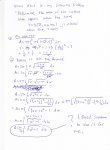You are using an out of date browser. It may not display this or other websites correctly.
You should upgrade or use an alternative browser.
You should upgrade or use an alternative browser.
y = 2 Sqrt x from o to 1 (Curve , and Area)
- Thread starter Riazy
- Start date
D
Deleted member 4993
Guest
Riazy said:Hi guys you can see my problem in the attachment
I would be happy if someone could solve the last part for me, and show it in detail
[attachment=0:298a3mdd]IMG_0003.jpg[/attachment:298a3mdd]
Thank you very much
Substitute
u = sec(?)
Don't forget to change the limits
mmm4444bot
Super Moderator
- Joined
- Oct 6, 2005
- Messages
- 10,902
If you were to substitute sec(?) for u, then you would have sec(?)^2.
There is a Pythagorean trig-identity that allows us to express sec(?)^2 in terms of the tangent function.
Are you familiar with it?
Last edited:
D
Deleted member 4993
Guest
Well - then I don't know how to do it.
After substitution and back substitution the answer would be
1/2*[x?(x[sup:36k0m72k]2[/sup:36k0m72k]-1)-log{2[?(x[sup:36k0m72k]2[/sup:36k0m72k]-1)+x]}] + C
Strange - scandanavian countries score very high in math competitions.
After substitution and back substitution the answer would be
1/2*[x?(x[sup:36k0m72k]2[/sup:36k0m72k]-1)-log{2[?(x[sup:36k0m72k]2[/sup:36k0m72k]-1)+x]}] + C
Strange - scandanavian countries score very high in math competitions.
For integrals of the form \(\displaystyle \int\sqrt{u^{2}-a^{2}}du\)
use the hyperbolic sub \(\displaystyle u=a\cdot cosh(t), \;\ du=a\cdot sinh(t)dt\)
In your case, a=1.
They come in handy for integrals of this form.
Makes for an easier integration than with the sec sub anyway. At least, I always thought so.
Continuing:
\(\displaystyle \frac{\pi}{2}\int_{1}^{3}\sqrt{u^{2}-1}du\)
Make the sub \(\displaystyle u=cosh(t), \;\ du=sinh(t)dt\)
\(\displaystyle \frac{\pi}{2}\int_{0}^{cosh^{-1}(3)}sinh^{2}(t)dt\)
\(\displaystyle \frac{\pi}{2}\int_{0}^{cosh^{-1}(3)}\frac{1}{2}(cosh(2t)-1)dt\)
\(\displaystyle \frac{\pi}{2}\left(\frac{1}{4}sinh(2t)-\frac{t}{2}\right)\left|_{0}^{cosh^{-1}(3)}\right\)
\(\displaystyle \approx 5.28\)
Do y'all use hyperbolic trig in Sweden?.
use the hyperbolic sub \(\displaystyle u=a\cdot cosh(t), \;\ du=a\cdot sinh(t)dt\)
In your case, a=1.
They come in handy for integrals of this form.
Makes for an easier integration than with the sec sub anyway. At least, I always thought so.
Continuing:
\(\displaystyle \frac{\pi}{2}\int_{1}^{3}\sqrt{u^{2}-1}du\)
Make the sub \(\displaystyle u=cosh(t), \;\ du=sinh(t)dt\)
\(\displaystyle \frac{\pi}{2}\int_{0}^{cosh^{-1}(3)}sinh^{2}(t)dt\)
\(\displaystyle \frac{\pi}{2}\int_{0}^{cosh^{-1}(3)}\frac{1}{2}(cosh(2t)-1)dt\)
\(\displaystyle \frac{\pi}{2}\left(\frac{1}{4}sinh(2t)-\frac{t}{2}\right)\left|_{0}^{cosh^{-1}(3)}\right\)
\(\displaystyle \approx 5.28\)
Do y'all use hyperbolic trig in Sweden?.
mmm4444bot
Super Moderator
- Joined
- Oct 6, 2005
- Messages
- 10,902
Riazy said:No I am not familiar with sec at all
Then you must be familiar with sine, cosine, and tangent, yes?
Each of those three trigonometric functions has a reciprocal, and the reciprocals are named as the cosecant, secant, and cotangent functions, respectively.
csc = 1/sin
sec = 1/cos
cot = 1/tan
There are three Pythagorean trig identities:
sin^2 + cos^2 = 1
1 + cot^2 = csc^2
tan^2 + 1 = sec^2
Last edited:

